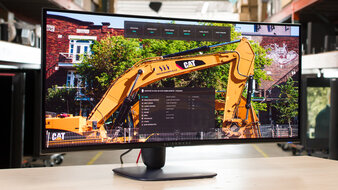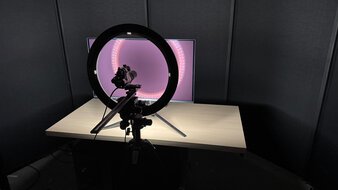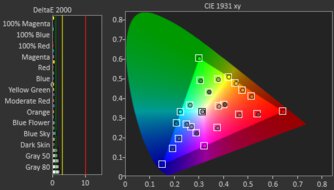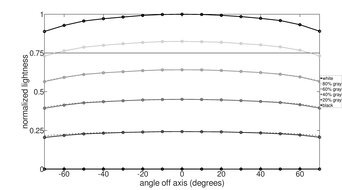It can be difficult to decide what gaming monitor size to get when there are so many options available. Ultimately, size is a personal choice, so you should get something you feel comfortable gaming with, but there are a ton of different sizes to choose from with various aspect ratios. There are some factors you may want to consider, though, like how far you sit from the screen and your budget, as bigger monitors tend to cost more.
That said, the monitor market for each size is different, meaning the specs you tend to find on smaller monitors are different from those of larger, ultrawide gaming monitors. So besides the size, you should also think about what type of features you want, like if you want a high refresh rate or a high resolution, as choosing the right size can depend on those.
In this article, we break down the most common monitor sizes for gaming, the pros and cons of getting each size, and the top recommended monitor in each category. However, if you're unsure about which size to get and you want to learn more before making a buying decision, you can also check out our monitor sizing guide.
We've bought and tested over 365 monitors, and below you'll find our recommendations for the most common and best gaming monitor size. Also, see our recommendations for the best gaming monitors, the best 1440p gaming monitors, and the best 4k gaming monitors.
Quick Look






We buy and test more than 30 monitors each year, with units that we buy completely on our own, without any cherry-picked units or samples. We put a lot into each unbiased, straight-to-the-point review, and there's a whole process from purchasing to publishing, involving multiple teams and people. We do more than just use the monitor for a week; we use specialized and custom tools to measure various aspects with objective data-based results. We also consider multiple factors before making any recommendations, including the monitor's cost, its performance against the competition, and whether or not it's easy to find.
-
Best 27-Inch Gaming Monitor
 PC Gaming9.1Console Gaming9.4Response Time9.9HDR Picture9.4SDR Picture10Brightness7.2Size27"Pixel TypeQD-OLEDMax Refresh Rate240 HzSee all our test resultsNative Resolution3840 x 2160
PC Gaming9.1Console Gaming9.4Response Time9.9HDR Picture9.4SDR Picture10Brightness7.2Size27"Pixel TypeQD-OLEDMax Refresh Rate240 HzSee all our test resultsNative Resolution3840 x 216027-inch monitors are some of the most commonly available and popular displays. They're a good choice if you don't want a monitor that takes up too much space, but you still want an immersive gaming experience. You can find them from basic 1080p displays to high-resolution 4k screens, so there's something to choose from, no matter the type of gamer you are. Monitors of this size are also available with different refresh rates, going as high as 480Hz.
The ASUS ROG Swift OLED PG27UCDM is the best 27-inch gaming monitor we've tested. It has a 4k resolution and a 240Hz refresh rate, making it outstanding for PC gaming. Thanks to its near-instantaneous response time, it delivers extremely sharp motion, so there's no blur behind fast-moving objects. Its QD-OLED panel also provides outstanding picture quality with vivid colors and deep blacks in dark rooms. It has USB-C connectivity and a KVM switch, making it easy to multitask with different computers, too. It's an expensive option, but there are lower-end and cheaper models available, like the 1440p ASUS ROG Strix OLED XG27ACDNG and the 4k Acer Nitro XV275K P3biipruzx, which has Mini LED backlighting, so there are plenty of options to choose from.
-
Best 32-Inch Gaming Monitor
 PC Gaming9.1Console Gaming9.2Response Time9.9HDR Picture9.4SDR Picture10Brightness7.0Size32"Pixel TypeQD-OLEDMax Refresh Rate240 HzSee all our test resultsNative Resolution3840 x 2160
PC Gaming9.1Console Gaming9.2Response Time9.9HDR Picture9.4SDR Picture10Brightness7.0Size32"Pixel TypeQD-OLEDMax Refresh Rate240 HzSee all our test resultsNative Resolution3840 x 2160If you want something bigger than a 27-inch monitor for more screen space, a 32-inch display is the best gaming monitor size for your needs. This monitor size is growing in popularity and availability, and there are plenty of options with high 4k resolutions. These are versatile for both PC and console gamers as they tend to include high-bandwidth ports, including HDMI 2.1 bandwidth to take full advantage of the PS5, PS5 Pro, and Xbox Series X|S. However, there aren't as many good budget-friendly displays in this size, so it's better to go for a smaller display if you're on a tighter budget.
If you want the best 32-inch gaming monitor, check out the ASUS ROG Swift OLED PG32UCDM. It's a premium display that's ideal for both PC and console gaming, thanks to its high refresh rate and resolution. It provides outstanding picture quality on its QD-OLED display, with bright highlights, vivid colors, and Dolby Vision support. It also has great connectivity, as it delivers up to 90W of power over USB-C and has a KVM switch, which is helpful if you have two PCs connected to the monitor. While its max 240Hz refresh rate is great for PC gaming, there are some 32-inch monitors with Dual-Mode features that increase the refresh rate to 480Hz with a 1080p resolution. The LG 32GS95UE-B has that feature, so it's versatile for playing different types of games, but it has less vivid colors than the ASUS.
-
Best 34-Inch Gaming Monitor
 PC Gaming9.1Console Gaming9.1Response Time9.8HDR Picture9.4SDR Picture10Brightness6.8Size34"Pixel TypeQD-OLEDMax Refresh Rate240 HzSee all our test resultsNative Resolution3440 x 1440
PC Gaming9.1Console Gaming9.1Response Time9.8HDR Picture9.4SDR Picture10Brightness6.8Size34"Pixel TypeQD-OLEDMax Refresh Rate240 HzSee all our test resultsNative Resolution3440 x 1440Although there are bigger screens than 32 inches that maintain a 16:9 aspect ratio, like the LG 42 OLED Flex, these monitors are less common. Instead, 34-inch displays with a 21:9 aspect ratio, known as ultrawide, are more popular and easier to find. Most ultrawide displays of this size have a 3440x1440 resolution, and while 38-inch monitors are available, the market for these is limited. Ultrawide monitors are best suited for immersive games as you can see more at once than on narrower displays, even if there's less physical screen space than on a 32-inch, 16:9 display.
The best 34-inch ultrawide gaming monitor we've tested is the Dell Alienware AW3425DW. It's an amazing gaming monitor with a QD-OLED panel, like the ASUS ROG Swift OLED PG27UCDM and the ASUS ROG Swift OLED PG32UCDM, that delivers both a fast response time and remarkable picture quality. It also has the same 240Hz refresh rate as the previously mentioned monitors, which is great for fast-paced games. It has fewer features than the ASUS monitors, though, as it doesn't support DisplayPort Alt Mode and lacks a KVM switch. You can also check out the similar MSI MPG 341CQPX QD-OLED if that's important to you, but it sometimes costs more than the Dell.
-
Best 49-Inch Gaming Monitor
 PC Gaming9.1Console Gaming8.2Response Time9.8HDR Picture9.5SDR Picture10Brightness6.8Size49"Pixel TypeQD-OLEDMax Refresh Rate240 HzSee all our test resultsNative Resolution5120 x 1440
PC Gaming9.1Console Gaming8.2Response Time9.8HDR Picture9.5SDR Picture10Brightness6.8Size49"Pixel TypeQD-OLEDMax Refresh Rate240 HzSee all our test resultsNative Resolution5120 x 1440While most gaming monitors are available with 34-inch screens or smaller, a handful of models have larger screen sizes, mainly in the 40- to 49-inch range. Not all large monitors are the same, but they're great if you want an immersive gaming experience, have space for such a large screen, and your budget allows for these premium models. They're also good alternatives to a multi-monitor setup. However, the market for bigger displays is more limited than for smaller ones.
If you want a 49-inch super ultrawide monitor, the Samsung Odyssey OLED G9/G95SC S49CG95 is the best one we've tested, as it has a fast 240Hz refresh rate. It has a super ultrawide 32:9 aspect ratio, providing even more horizontal screen space than the Dell Alienware AW3425DW, and it also features a QD-OLED panel with outstanding picture quality and crisp motion handling. Its 49-inch screen is the equivalent of placing two 27-inch, 1440p monitors side by side, so it offers an immersive feel. However, you can also check out the 45-inch LG 45GX950A-B, which has a higher 5120x2160 resolution, if you want more detailed images. That said, it has a 21:9 aspect ratio, so it has a bigger screen height instead of more horizontal screen space, which is something you may need to consider in terms of preference.
-
Best 24-25 Inch Gaming Monitor
 PC Gaming7.2Console Gaming5.7Response Time7.7HDR Picture4.7SDR Picture6.3Brightness7.5Size25"Pixel TypeIPSMax Refresh Rate360 HzSee all our test resultsNative Resolution1920 x 1080
PC Gaming7.2Console Gaming5.7Response Time7.7HDR Picture4.7SDR Picture6.3Brightness7.5Size25"Pixel TypeIPSMax Refresh Rate360 HzSee all our test resultsNative Resolution1920 x 1080If any of the recommended sizes above are too big for your needs, there are some smaller options you can consider. The smallest size you can get now for modern gaming monitors is 24 to 25 inches, and even though there are some smaller displays available, like portable monitors, they aren't as good for gaming. Getting a monitor of this size is ideal if you don't have a ton of desk space for a 27-inch monitor, and it's helpful if you want to see everything within your field of vision without moving your eyes too much. Gaming options in this size tend to have high refresh rates with a 1080p resolution, which makes them ideal for competitive gaming, and the low resolution isn't too demanding on your graphics card either.
The best 25-inch monitor we've tested is the Dell Alienware AW2523HF, which you can get directly from Dell's website. Like most monitors in this size range, it's meant for esports gaming as it has a high 360Hz refresh rate and VRR support to reduce screen tearing. It has a consistently fast response time at any refresh rate, so fast-moving objects look sharp. It doesn't cost much either, but if you're on a tighter budget, the ViewSonic XG2431 is a great entry-level 24-inch monitor, but it has a lower 240Hz refresh rate than the Dell.
Recent Updates
Sep 09, 2025:
We replaced the MSI MPG 341CQPX QD-OLED with the Dell Alienware AW3425DW for consistency with other recommendations as the Dell tends to cost less for similar performance.
May 09, 2025:
Replaced the MSI MPG 271QRX QD-OLED with the ASUS ROG Swift OLED PG27UCDM, as it has a more detailed image. Replaced the MSI MPG 321URX QD-OLED with the ASUS ROG Swift OLED PG32UCDM, as the MSI is harder to find right now.
Feb 19, 2025:
To be consistent with other articles, we replaced the Samsung Odyssey OLED G8/G80SD S32DG80 with the MSI MPG 321URX QD-OLED in the 32-inch category. We also introduced a new format to the article and updated the text to reflect these changes.
Dec 09, 2024:
Replaced the Gigabyte AORUS FO27Q3 with the MSI MPG 271QRX QD-OLED, as the Gigabyte is harder to find. Replaced the Dell Alienware AW3423DWF with the MSI MPG 341CQPX QD-OLED, as the MSI has a higher refresh rate.
Sep 16, 2024: We replaced the Dell Alienware AW2524H with the Dell Alienware AW2523HF because the AW2524H is hard to find. We also replaced the Dell Alienware AW3225QF with the Samsung Odyssey OLED G8/G80SD S32DG80 in the 32-inch category for consistency with other recommendations.
All Reviews
Our recommendations are based on what we think are the best gaming monitor size options. They're adapted to be valid for most people. The rating is based on our review, factoring in price and feedback from our visitors.
If you would prefer to make your own decision, here is the list of all of our monitor reviews. Be careful not to get too caught up in the details. Most monitors are good enough to please most people, and the things we fault monitors on are often not noticeable unless you really look for them.















